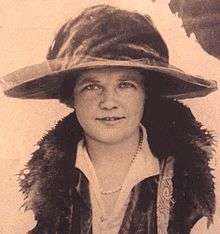Margaret Mackworth, 2nd Viscountess Rhondda
| The 2nd Viscountess Rhondda | |
|---|---|
 Margaret Mackworth, c. 1915 | |
| Born |
Margaret Haig Thomas 12 June 1883 Newport, Wales |
| Died |
20 July 1958 (aged 75) London, England, U.K. |
| Known for | Suffragette and women's rights campaigner; business woman; Lusitania survivor |
| Spouse(s) | Sir Humphrey Mackworth (1908–1922) (divorced) |
| Parent(s) |
Sybil Margaret Haig David Alfred Thomas |
Margaret Haig Mackworth, 2nd Viscountess Rhondda (12 June 1883 – 20 July 1958) was a Welsh peeress, businesswoman, and active suffragette. She was significant in the history of women's suffrage in the United Kingdom.
Biography
Margaret Haig Thomas was born on 12 June 1883 in London. Her parents were David Alfred Thomas, first Viscount Rhondda, and Sybil Haig, also a suffragette. In her autobiography, Margaret wrote that her mother had 'prayed passionately that her baby daughter might become feminist'. And indeed she did become a passionate activist for women's rights.
She was an only child, and although she was born in London, she lived in Llanwern, near Newport, until the age of 13 when she went away to boarding school, first to Notting Hill High School then St Leonards School in St Andrews. In 1904, aged 19, she took up a place at Somerville College, Oxford, where she studied history. Despite her tutors providing positive feedback on her academic progress, she returned to Llanwern to live with her family after two terms.
In 1908 she joined the Women's Social and Political Union (WSPU), and became secretary of its Newport branch and a supporter of its militant campaign. Between 1908 and 1914, she took the campaign for women's suffrage across South Wales, often to hostile and stormy meetings. She was involved in protest marches with the Pankhursts, jumping onto the running board of Liberal Prime Minister H. H. Asquith's car in St Andrews and attempting to destroy a post-box with a chemical bomb.[1] These activities resulted in a trial at the Sessions House, Usk and her serving a period of time in the prison there. She was released only after going on a hunger strike.[2]
On the outbreak of the First World War, she accepted the decision by the WSPU leadership to abandon its militant campaign for suffrage. She worked with her father, who was sent by David Lloyd George to the United States to arrange the supply of munitions for the British armed forces. In May 1915, she was returning from the United States on the RMS Lusitania with her father and his secretary Arnold Rhys-Evans, when it was torpedoed by a German submarine. The trio were among the survivors.
After her father's death, Lady Rhondda tried to take his seat in the House of Lords, citing the Sex Disqualification (Removal) Act 1919 which allowed women to exercise "any public office". The Committee of Privileges, after an initially warm reaction, eventually voted strongly against Lady Rhondda's plea.[3] She was supported for many years by Lord Astor, whose wife Nancy had been the first woman to take her seat in the House of Commons, but Lady Rhondda never entered the Lords.[4]
She succeeded her father as chairman of the Sanatogen Company in February 1917.[5] In 1920, she founded Time and Tide magazine. In total, she was a director of 33 companies throughout her life, having inherited 28 directorships from her father. The majority of her business interests were in coal, steel and shipping. Passionate about increasing the amount of women in the corporate world, Margaret was involved in creating and chairing the Efficiency Club, a networking organisation for British businesswomen.
In 1921 she set up the Six Point Group an action group that focused heavily on the equality between men and women and the rights of the child.[6]
The group's manifesto of equal rights for women within the workplace, and for mothers and children, sought the following:
- Satisfactory legislation on Child Assault
- Satisfactory legislation for the Widowed Mother
- Satisfactory legislation for the Unmarried Mother and her Child
- Equal rights for Guardianship for Married Parents
- Equal pay for Teachers
- Equal Opportunities for men and women in the Civil Service
A Canadian steamship, the Lady Mackworth, was named after her.[7]
Less than a month after Lady Rhondda's death in 1958, women entered the Lords for the first time thanks to the Life Peerages Act 1958; five years later, with the passage of the Peerage Act 1963, hereditary peeresses were also allowed to enter the Lords.
Lady Rhondda was elected as the Institute of Directors' first female president in 1926, and in 2015, the annual Mackworth Lecture was launched by the IoD in her honour.[8]
Personal life
In 1908 she married Sir Humphrey Mackworth, Bt (see Mackworth Baronets). They divorced in 1923 and she never remarried. She did have some significant relationships over the course of her life. She lived with Time and Tide magazine editor Helen Archdale in the late 1920s, and subsequently spent 25 years living with writer and editor Theodora Bosanquet.[9]
See also
References
- ↑ "Suffragette Viscountess Rhondda's Newport bomb attack remembered". BBC Wales News.
- ↑ "2nd Viscountess Rhondda, Politician and businesswoman" at bbc.co.uk
- ↑ Viscountess Rhondda's Claim [1922] 2 AC 339.
- ↑ Margaret, Lady Mackworth: The Lusitania Resource.
- ↑ "Lady Mackworth" (PDF). British Journal of Nursing. 58: 125. 17 February 1917.
- ↑
- Wallace, Ryland (2009). The Women's Suffrage Movement in Wales, 1866–1928. Cardiff: University of Wales Press. p. 255. ISBN 978-0-708-32173-7.
- ↑ "2nd Viscountess Rhondda Politician and businesswoman". BBC South East Wales.
- ↑ "Institute of Directors launch annual Mackworth Lecture"
- ↑ "A Bird in a Cage - A Bird In A Cage". www.abirdinacage.org. Retrieved 2016-12-08.
Sources
| Peerage of the United Kingdom | ||
|---|---|---|
| Preceded by David Alfred Thomas |
Viscountess Rhondda 1919–1958 |
Succeeded by Title extinct |